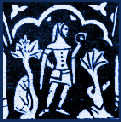 |
Background information
Design elements
|
| |
Using local
sources
We wanted to give the design elements on the Project web site
a strong local focus, even if this was not apparent to persons
browsing the site. To this end, virtually all of the backgrounds
and buttons used throughout the site have been adapted from images
with a local connection to each of the historic counties of Breconshire,
Radnorshire and Montgomeryshire. Here are some of the most
common, with an explanation of where they came from. |
| |
 |
This image, which we used as a "bullet
point" for selecting menu items, is in fact a medieval deed
from the 14th century and may well be the Archives Office's oldest
document. It comes from a collection transferred from Brecknock
Museum.
(ref. B/D/BM/A/46/1) |
| |
 |
These wood-effect buttons which are
used on nearly all the pages for navigation have an unusual origin.
The wooden background is taken from a digital photograph of the
17th century box pews at Disserth church in Radnorshire. This
charming parish church is one of the few to escape 19th century
"restoration" and we wanted to commemorate this on
the site in some way. |
| |
 |
In the same way, the Digital History
Project logo is taken from a close shot of the masonry of the
Disserth church tower wall.
The editing software,Paint Shop Pro, was used to add colour to
the background image and add borders and shadows. |
| |
 |
This image, which was also used as
the background to the original opening page on the site, appears
as a decoration on some other pages. It is taken from a report
of the excavations of the abbey at Strata Marcella in
Montgomeryshire published in the Montgomeryshire Collections
and appears by kind permission of the Powysland Club.
The original tile may be found at the Powysland Museum in
Welshpool. |
| |
Finally, the background image which appears on
this and most other pages is taken from a drawing of the famous
rood screen at the chapel at Pennant Melangell in Montgomeryshire
published in the Montgomeryshire Collections, and also
appears by kind permission of the Powysland Club. |
 |
|
 |
|


